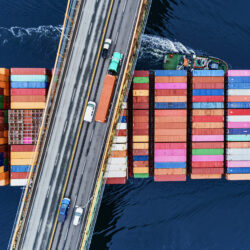Agco achieves savings with end-to-end Transport Management System

Machinery manufacturer Agco has grown rapidly through acquisitions, which led to a complex supply chain with little cohesion. With a large-scale transformation project, Agco has turned the competition’s backlog into an advantage. Part of this transformation comes from the implementation of the end-to-end Transport Management System (TMS) from Alpega Group. Michael Bülow, Senior Manager Transportation, Logistics, Customs Compliance & Indirect Purchasing EME from Agco shared his experiences during a new SCM webinar. “We broke even within 12 months,” he said.
By Marcel te Lindert
When asked what the advantages of an end-to-end transport management system are, Alpega’s VP of Sales Strategy & Alliances Michael Boeckle, had a simple answer. “The larger the scope of the solution, the greater the benefits and the greater the savings,” Boeckle stated. According to him, an end-to-end TMS includes both inbound and outbound transport, whether by road, water or air. Optimizing these processes starts with strategic issues such as network design, location of hubs and selection of transport partners. This is followed by tactical issues such as the frequency of connections between the hubs.
In the planning and execution of transport, Boeckle sees an important role for marketplaces such as Teleroute and Wtransnet, both part of Alpega Group. ”We regularly see companies using these marketplaces to check whether the rates of their regular carriers are still in line with the market. We also link our TMS to solutions for real-time visibility such as Shippeo, Project44 or FourKites.”
Complex supply chain
Agco has been working on end-to-end TMS in recent years. The agricultural machinery manufacturer with brands such as Fendt, Valtra and Massey Ferguson has grown rapidly through acquisitions. The result is a complex supply chain with 54 factories, 6,000 suppliers and 14,500 origin-destination pairs. “What makes the supply chain extra complex is the volatility. Farmers’ investment capacity depends on the prices of their products on the world market. Because these prices fluctuate greatly, we also have to be flexible in terms of production capacity,” explains Bülow. “At the same time, following the example of the automotive industry, we are increasingly working with uniform, modular product platforms on which we can build several models. This brings cost benefits but also means that we are increasingly moving towards a global supply chain.”
In 2012, Agco embarked on a major transformation project, part of which was the implementation of a new TMS. After all, transport costs are one of the biggest cost items within Agco. “The supply chain consisted of more or less independently operating links, with a focus on the short term,” Bülow said. “We wanted to move towards a more integrated, proactive supply chain with more focus on long-term strategy. Part of this was the implementation of standard tools for the entire supply chain, including an end-to-end TMS. So now we are building a competitive advantage with global and regional control towers.”
Hybrid transport management team
In their search for the ideal set-up for controlling the global transport network, Agco formulated three scenarios: setting up its own central transport management team; outsourcing to a neutral chain director or fourth party logistics provider (4PL); or a blended approach. “We opted for the third scenario: a hybrid variant in which we manage the transport network together with a 4PL and a common TMS. This hybrid team acts as an internal logistics service provider for our factories,” Bülow explained.
The new set-up, including the TMS, was put in place within a year and a half. The network that controls the hybrid team includes 35 factories, 3,000 suppliers and 5,000 dealers. More than 150 carriers are connected to the network, carrying out more than 30,000 transport orders per month. “Within 12 months, we had recovered the investment in the new set-up,” said Bülow.
Cost reduction
The hybrid team is divided into three parts, each with its own focus area. The transport management team focuses on strategic issues and the selection of carriers. The transport planning team focuses on optimization and implementation of changes in the network. The day-to-day operations are in the hands of the transport execution team. In Europe and Asia, transport planning and execution is in the hands of 4flow management, the 4PL that Agco outsourced. “This is a 4PL service core competence which we wanted to leverage from the first day of our collaboration with 4flow management. Another reason for outsourcing is the flexibility in costs. Globally, all teams use the same systems and processes,” Büllow explains.
The implementation of the end-to-end TMS has led to a reduction of transport costs while transport performance – the number of shipments delivered on time – has increased by 25%. “This is mainly due to the improved visibility. Because the transparency and reliability of the supply chain has improved, we have also managed to reduce inventory levels by 24%,” Bülow shared, who sees further process improvement opportunities. “We are now working on robotic process automation (RPA), to digitalize and integrate the link between our TMS processes and our revenue recognition processes. In addition, we are now implementing Shippeo’s real-time visibility solution.”
Horizontal cooperation
According to Alpega, Agco is well on its way to the highest level of maturity when it comes to transport management. The TMS vendor distinguishes three levels in total:
- Level one: Companies improve cooperation in the transport network with a central platform to which carriers and suppliers are connected.
- Level two: Companies deal with more strategic issues such as the design and optimization of the transport network which can lead to cost savings of 10% or more.
- Level three: Companies have optimized internally and are looking for other possibilities, such as cooperating with other companies by bundling flows.
“Agco is on its way to the third level,” Boeckle said. He sees this horizontal cooperation taking shape, with further cost savings within reach. “At the moment, this is still an area where companies can gain a competitive edge. But within three to five years, horizontal cooperation will become a ‘must have’ for all shippers.”










